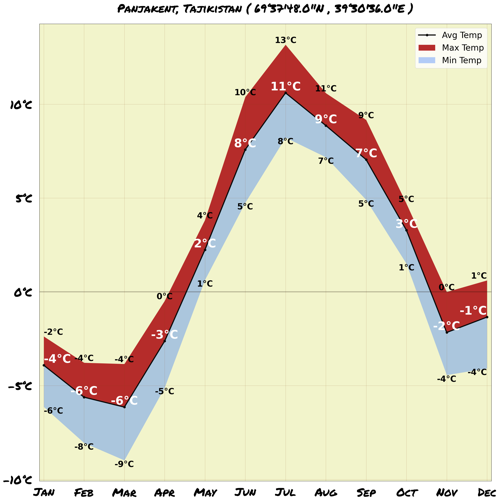Understand
Penjikent, a name derived from "panj" meaning "five" and "kant" meaning "settlements," is a place steeped in history. Located in the Zarafshan Valley, just east of Samarkand, the ruins of ancient Penjikent hold tales of a bygone era. As one of the easternmost cities of Sogdia, Penjikent remains a fascinating archaeological site, thanks to the extensive excavations led by renowned experts. The city dates back to the 5th century and thrived until the 770s. Today, Penjikent is renowned for its exquisite frescoes, with some displayed in the small Rudaki Museum at Penjikent, and others showcased in the grand museums of Dushanbe and St. Petersburg.
Get in
Embarking on a travel experience in Panjakent and the Zeravshan valley is often done by entering from the captivating city of Samarkand in Uzbekistan. However, do keep in mind that you will require a valid Tajik visa to enter and a double/multi-entry Uzbek visa if you plan on returning the same way. Crossing the border does not involve public transport, so if you haven't arranged your trip through one of the Uzbek tour agents, you'll need to switch taxis at the border. The journey from Pandjakent Koutchasi in the south-eastern part of the Registan to the border takes around 30 minutes and costs US$3 per person. From the border, it takes another 30 minutes and another US$3 per person. Alternatively, travel agents in Samarkand offer a comprehensive trip package for approximately US$40, which includes transportation, a guide, admission fees, and even the "border crossing fee." It's important to note that the Samarkand-Panjakent border crossing has been closed since January 2012, with no indication of reopening in the near future. However, as of March 1, 2018, the border has been reopened, allowing travelers to explore these mesmerizing destinations once again. If you're coming from Khujand or Dushanbe, brace yourself for a breathtaking 4-hour journey in a shared taxi to reach Panjakent. The cost for a seat in 2017 was around 275TJS for the Dushanbe-Panjakent portion. The road is generally in good condition, but occasional landlides may require repairs. The distance from Dushanbe is approximately 230 km, and you'll have the opportunity to pass through the stunning Varzob Gorge and cross the impressive 3,370 m high Anzab Pass. Back in 2006, a remarkable 5 km long Anzab Tunnel was opened to ease travel. If you're departing from Khujand, you'll conquer the Shakristan Pass with an elevation of 3,380 m. For those seeking a different mode of transportation, Panjakent also boasts an airport from which small planes occasionally fly to Dushanbe. Be aware that there is no fixed schedule for these flights, but if the mountain passes are closed and a sufficient number of travelers have gathered, Tajik air may organize a trip or two.
Map & Climate
Popular Foods
 Plov (also known as Osh or Plov) - This national dish of Tajikistan is a hearty rice pilaf that often contains meat, typically lamb or beef, as well as carrots, onions, and other seasonings. The dish is cooked slowly, allowing the flavors to meld together into a delicious, aromatic experience. Plov is often served with additional sprinklings of garlic, cilantro, and paprika, adding to its richness.
Plov (also known as Osh or Plov) - This national dish of Tajikistan is a hearty rice pilaf that often contains meat, typically lamb or beef, as well as carrots, onions, and other seasonings. The dish is cooked slowly, allowing the flavors to meld together into a delicious, aromatic experience. Plov is often served with additional sprinklings of garlic, cilantro, and paprika, adding to its richness. Qurut - A popular Tajikistani snack made from sunflower seeds, Qurut is prepared by soaking the seeds overnight and then drying them out again. Once dried, the seeds are roasted and eaten as a crunchy, nutritious treat. Sometimes, they're seasoned with salt or mixed with herbs for added flavor. Qurut is known for being an energy-boosting snack, making it a staple for those living in mountainous regions.
Qurut - A popular Tajikistani snack made from sunflower seeds, Qurut is prepared by soaking the seeds overnight and then drying them out again. Once dried, the seeds are roasted and eaten as a crunchy, nutritious treat. Sometimes, they're seasoned with salt or mixed with herbs for added flavor. Qurut is known for being an energy-boosting snack, making it a staple for those living in mountainous regions. Felafel (Falafel) - Tajikistan's adaptation of the Middle Eastern classic, Felafel is a fried ball made primarily from crushed chickpeas, herbs, and spices. These tasty treats are often served as a standalone snack or embedded within a sandwich, accompanied by fresh vegetables and sauces. While traditionally a vegetarian dish, some variations may contain small amounts of meat.
Felafel (Falafel) - Tajikistan's adaptation of the Middle Eastern classic, Felafel is a fried ball made primarily from crushed chickpeas, herbs, and spices. These tasty treats are often served as a standalone snack or embedded within a sandwich, accompanied by fresh vegetables and sauces. While traditionally a vegetarian dish, some variations may contain small amounts of meat.




Comments
NO COMMENTS